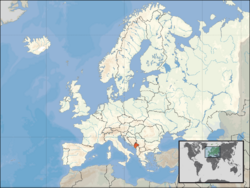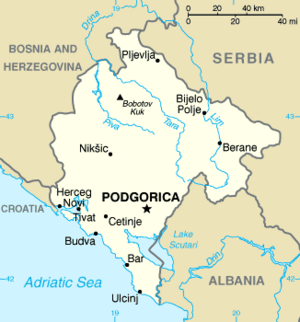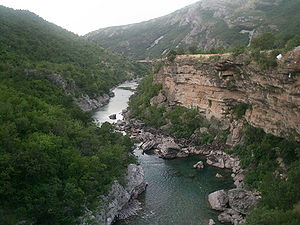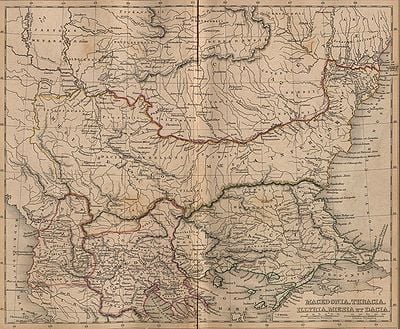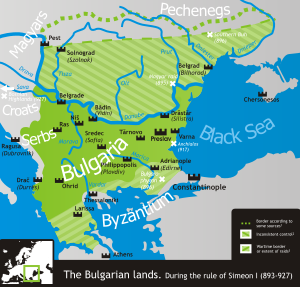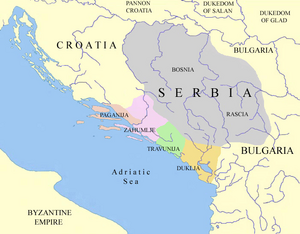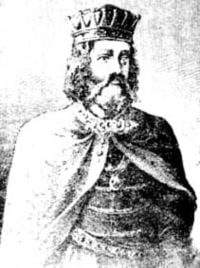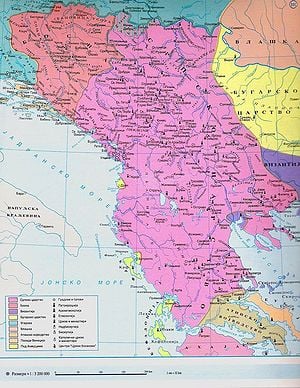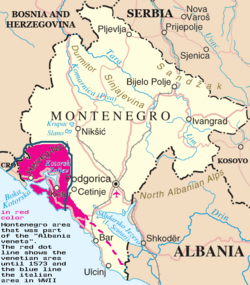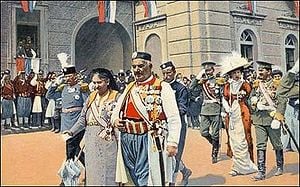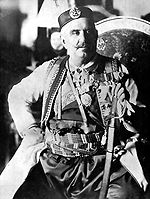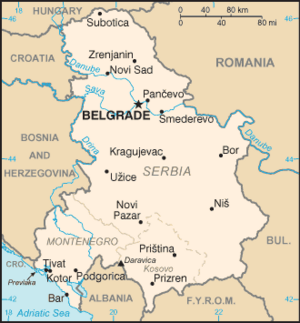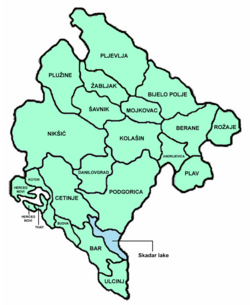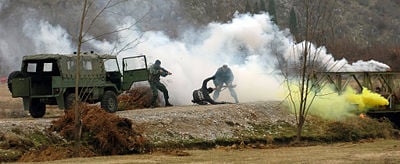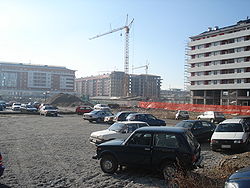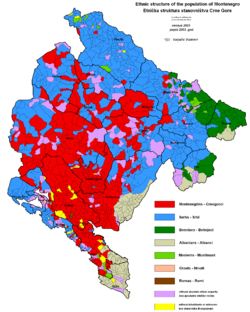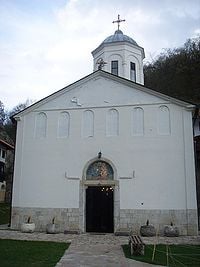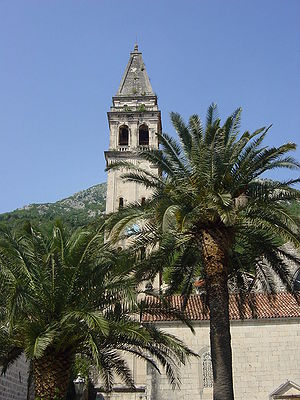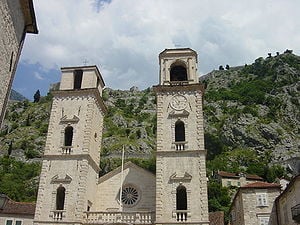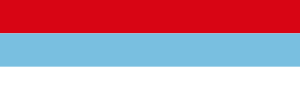Difference between revisions of "Montenegro" - New World Encyclopedia
Mike Butler (talk | contribs) |
Mike Butler (talk | contribs) (→Art) |
||
| Line 278: | Line 278: | ||
===Religion=== | ===Religion=== | ||
| − | |||
[[Image:Manastir_pv.JPG|thumb|200px|right|The monastery of the Holy Trinity in Pljevlja.]] | [[Image:Manastir_pv.JPG|thumb|200px|right|The monastery of the Holy Trinity in Pljevlja.]] | ||
Montenegro is a multireligious country. Although [[Eastern Orthodox Church|Orthodox Christianity]] is the dominant religion, there are also numerous adherents of [[Islam]] and [[Catholics|Catholic Christianity]]. The dominant Church is the [[Serbian Orthodox Church]] - although traces of a forming [[Montenegrin Orthodox Church]] are present. According to 2003 census, major religious groups in Montenegro were: [[Orthodox Christians]] 74.24 percent, [[Sunni Muslims]] 17.74 percent, and [[Roman Catholics]] 3.54 percent. No other religious group in Montenegro, including [[Protestants]] and [[Jews]], reaches 1 percent. | Montenegro is a multireligious country. Although [[Eastern Orthodox Church|Orthodox Christianity]] is the dominant religion, there are also numerous adherents of [[Islam]] and [[Catholics|Catholic Christianity]]. The dominant Church is the [[Serbian Orthodox Church]] - although traces of a forming [[Montenegrin Orthodox Church]] are present. According to 2003 census, major religious groups in Montenegro were: [[Orthodox Christians]] 74.24 percent, [[Sunni Muslims]] 17.74 percent, and [[Roman Catholics]] 3.54 percent. No other religious group in Montenegro, including [[Protestants]] and [[Jews]], reaches 1 percent. | ||
| Line 317: | Line 316: | ||
== Culture == | == Culture == | ||
| − | + | The culture of Montenegro has been shaped by the Orthodox South Slavic, Central European, and seafaring Adriatic cultures (notably parts of [[Italy]], like the [[Republic of Venice]]). Important is the ethical ideal of ''Čojstvo i Junaštvo'', roughly translated as "humanity and bravery". It is the unwritten code of chivalry. In the old days of battle, it resulted in Montenegrins fighting to the death as being captured was considered the greatest shame. | |
| − | The culture of Montenegro has been shaped by | ||
| − | |||
| − | |||
===Architecture=== | ===Architecture=== | ||
| − | + | [[Image:Man savina.jpg|thumb|left|300px|Savina monastery near Herceg Novi.]] | |
| − | Montenegro has a number of significant cultural and historical sites, including heritage sites from the pre-[[Romanesque architecture|Romanesque]], [[Gothic art|Gothic]] and [[Baroque]] periods. The Montenegrin coastal region is especially well known for its religious monuments, including the [[Cathedral of Saint Tryphon]], the basilica of St. Luke (over 800 years), Our Lady of the Rock (Škrpjela), the [[Savina Monastery]] and others. Montenegro's medieval monasteries contain thousands of square metres of frescos on their walls. The [[Byzantine empire|Byzantine]] influence in architecture and in religious artwork is especially apparent in the country's interior. The ancient city of [[Kotor]] is listed on the [[UNESCO]] World Heritage list. | + | [[Image:Cathedral Kotor.JPG|thumb|300px|right|Cathedral of Saint Tryphon (Sv. Tripun) in Kotor.]] |
| − | + | Montenegro has a number of significant cultural and historical sites, including heritage sites from the pre-[[Romanesque architecture|Romanesque]], [[Gothic art|Gothic]] and [[Baroque]] periods. The Montenegrin coastal region is especially well known for its religious monuments, including the Roman Catholic [[Cathedral of Saint Tryphon]] in Kotor, which was consecrated in 1166, the basilica of St. Luke (over 800 years), Our Lady of the Rock (Škrpjela), the [[Serb Orthodox]] [[Savina Monastery]], near the city [[Herceg Novi]], and others. Montenegro's medieval monasteries contain thousands of square metres of frescos on their walls. The [[Byzantine empire|Byzantine]] influence in architecture and in religious artwork is especially apparent in the country's interior. The ancient city of [[Kotor]] is listed on the [[UNESCO]] World Heritage list. Although Podgorica has become an industrial city, much of the architecture of the older part of the city reflects the Turkish influence of the Ottoman Empire. Urban dwellers mostly live in apartment buildings. In the country, most houses are modest buildings of wood, brick, or stone. | |
| − | |||
| − | |||
| − | |||
| − | |||
| − | |||
| − | |||
| − | |||
| − | |||
| − | |||
Revision as of 21:02, 3 October 2007
| Република Црна Гора Republika Crna Gora Republic of Montenegro | |||||
| |||||
| Anthem: Oj, svijetla majska zoro "Oh, Bright Dawn of May" | |||||
| Capital | Podgorica 42°47′N 19°28′E | ||||
|---|---|---|---|---|---|
| Largest city | capital | ||||
| Official languages | Serbian (Ijekavian dialect)1 | ||||
| Government | Republic | ||||
| - President | Filip Vujanović | ||||
| - Prime Minister | Željko Šturanović | ||||
| Independence | due to the dissolution of Serbia and Montenegro | ||||
| - Declared | June 3, 2006 | ||||
| - Recognized | June 8, 2006 | ||||
| Area | |||||
| - Total | 13,812 km² (159th) 5,019 sq mi | ||||
| - Water (%) | 1.5 | ||||
| Population | |||||
| - July 2007 estimate | 684,736[1] | ||||
| - 2003 census | 620,145 | ||||
| - Density | 44.9/km² 115.6/sq mi | ||||
| GDP (PPP) | 2005 estimate | ||||
| - Total | $11,458 billion | ||||
| - Per capita | $3,800 | ||||
| HDI (2004) | 0.788[2] (medium) | ||||
| Currency | Euro2 (EUR)
| ||||
| Time zone | CET (UTC+1) | ||||
| - Summer (DST) | CEST (UTC+2) | ||||
| Internet TLD | .yu (.me)3 | ||||
| Calling code | +382 | ||||
| 1 The current DPS-SDP regime calls it Montenegrin language, introducing the term to official usage since last year. Albanian is co-official in the municipality of Ulcinj. 2 Adopted unilaterally; Montenegro is not a formal member of the Eurozone. 3 .me should come into use in 2007, while .yu is a holdover from Serbia and Montenegro which is still in use for Montenegrin subdomains [1]. | |||||
Montenegro (Serbian: Црна Гора or Crna Gora, officially The Republic of Montenegro (Serbian: Црна Гора, Crna Gora, meaning "black mountain") is a small, mountainous state in south-west Balkans, bordering Croatia, Bosnia and Herzegovina, Serbia, Albania and the Adriatic Sea.
De facto independent since the late Middle Ages, and an internationally recognised country from 1878 until 1918, Montenegro was later a part of various incarnations of Yugoslavia and the state union of Serbia and Montenegro.
Based on the results of the referendum held on May 21, 2006, Montenegro declared independence on June 3, 2006, and on June 28, 2006, it became the 192nd member state of the United Nations, and on May 11, 2007, the 47th member state of the Council of Europe.
Geography
With a land area 5019 square miles (13,812 square kilometers), Montenegro is slightly smaller than Connecticut. Montenegro ranges from high peaks along its borders with Serbia and Albania, a segment of the Karst of the western Balkan Peninsula, to a narrow coastal plain that is only one to four miles wide. The plain stops abruptly in the north, where Mount Lovćen and Mount Orjen plunge abruptly into the inlet of the Bay of Kotor.
Montenegro's large Karst region lies generally at elevations of 3281 feet (1000 meters) above sea level. Some parts rise to 6560 feet (2000 meters), such as Mount Orjen at 6214 feet (1894 meters), the highest massif among the coastal limestone ranges. The Zeta River valley, at an elevation of 1640 feet (500 meters), is the lowest segment.
The mountains of Montenegro include some of the most rugged terrain in Europe. They average more than 6560 feet (2000 meters) in elevation. One of the country's notable peaks is Bobotov Kuk in the Durmitor mountains, which reaches a height of 8274 feet (2522 meters). The Montenegrin mountain ranges were among the most ice-eroded parts of the Balkan Peninsula during the last glacial period.
Natural resources include bauxite and hydroelectricity.
Lower areas have a Mediterranean climate, with dry summers and mild, rainy winters. Temperature varies with elevation. Podgorica, near sea level, has the warmest July (summer) temperatures, averaging 81°F (27°C). Cetinje, in the Karst region at 2200 feet (670m), has an average temperature that is 10°F (5°C) lower. Average January (winter) temperatures at Bar on the southern coast are 46°F (8°C). Annual precipitation at Crkvice, in the Karst, is nearly 200 inches (5100 mm), during the cold part of the year. Snow cover is rare along the Montenegrin coast, increasing to 120 days in the higher mountains.
Runoff in the north enters the Lim and Tara rivers, which flow into the Drina River, which forms the border between Bosnia and Herzegovina and Serbia. In the south, streams flow toward the Adriatic. Drainage of the karst region travels in underground channels. Lake Scutari (Skadarsko Jezero), at 25 miles (40km) long and 10 miles (16km) wide, is the country's largest lake and extends into northern Albania. The mountains are noted for numerous smaller lakes.
One-third of Montenegro, mainly the high mountains, remains covered with broad-leaved forest. The southern Karst zone, lacking soils, remained forested through classical times, with oaks and cypresses predominating. Removal of forests for domestic fuel and construction led to soil erosion and ultimately, to regeneration in Mediterranean scrub known as maquis.
Sparsely populated Montenegro has numerous mammals, including bears, deer, martens, and wild pigs, as well as predatory wild animals, including wolves, foxes, and wildcats, along with a rich variety of birds, reptiles, and fish.
Destructive earthquakes are the main natural hazard. Environmental issues relate to the pollution of coastal waters from sewage outlets, especially in tourist-related areas such as Kotor
Its de facto capital and largest city is Podgorica, with a population in 2003 of 169,299. The favorable geographical position at the confluence of the Ribnica and Morača rivers, on the meeting point of fertile Zeta plain and Bjelopavlići Valley has made the city an attractive location for settlement. The city is situated only a few dozen kilometers from both winter ski centers in the north and seaside resorts on Adriatic Sea. The municipality of Podgorica accounts for 10.4 percent of Montenegro's territory and 27.3 percent of its population. Besides being an administrative center of Montenegro, Podgorica is also its economic, cultural and educational focal point.
Cetinje (population 20,307) is designated as Prijestonica, the old royal capital or seat of the throne. Other cities and towns include Nikšić (104,706), Pljevlja (44,593), Bijelo Polje (55,628), Herceg Novi (30,593, including Igalo), and Berane (49,953).
History
The lands that later became Montenegro were first populated in the Paleolithic Age (Stone Age), over 100,000 years ago. The population increased in the Neolithic age (c. 8000 B.C.E.), marked by the rise of farming. People began to abandon caverns and settle in open areas. The remains of a number of such settlements have been discovered in Montenegro. Stockbreeding people, who came from the east around the mid-3000s B.C.E. to the early 2000s B.C.E., mixed with the indigenous peoples and thus created the Indo-European peoples of the Balkans, believed to be the ancient Pelasgians mentioned frequently by ancient writers Homer, Herodotus, and Thucydides.
Illyria
The Illyrians were Indo-European tribesmen who appeared in the western portion of the Balkan Peninsula about 1000 B.C.E., a period coinciding with the beginning of the Iron Age. The Illyrians occupied lands extending from the Danube, Sava, and Morava rivers to the Adriatic Sea and the Sar Mountains.
Corinthian Greek settlers from Corfu established ports on the coast at Apollonia (Pojanë, near modern Vlorë, in Albania) in 588 B.C.E. and farther north at Lissos (Lezhë) and Epidamnos (modern Durrës) in 623 B.C.E.. The Illyrians living in Albania's rugged mountains, however, resisted Greek settlement, attacked coastal cities, and threatened Greek trading ships in the Adriatic Sea. The Illyrian king, Bardyllis turned Illyria into a formidable local power in the fourth century B.C.E., with its capital at Skadar (Albania).
In 358 B.C.E., Macedonia's Philip II, the father of Alexander the Great, defeated the Illyrians and assumed control of their territory as far as Lake Ohrid. Alexander himself routed the forces of the Illyrian chieftain Cleitus in 335 B.C.E., and Illyrian tribal leaders and soldiers accompanied Alexander on his conquest of Persia.
Roman rule
Between 229 – 219 B.C.E., Rome overran the Illyrian settlements in the Neretva river valley and suppressed the piracy that had made the Adriatic unsafe. The Romans defeated the last Illyrian king Gentius at Scodra in 168 B.C.E., captured him, and brought him to Rome in 165 B.C.E. Rome finally subjugated recalcitrant Illyrian tribes in the western Balkans during the reign of Emperor Tiberius in 9 C.E., and annexing them to the Roman province of Illyricum.
Parts of present-day Montenegro, Serbia, and Albania were known as the ancient Roman province of Praevalitana. It was formed during the reign of emperor Diocletian (284-305) from southeastern corner of the province of Dalmatia. "Doclea", the name of the region during the early period of the Roman Empire, was termed for an early Illyrian tribe - the Docleatae. The actual city of Dioclea was located at present-day Podgorica (throughout the Middle Ages known as Ribnica).
For about four centuries, Roman rule ended fighting among local tribes, established numerous military camps and colonies, latinized the coastal cities, and oversaw the construction of aqueducts and roads, including the extension of the Via Egnatia, an old Illyrian road and later a famous military highway and trade route that led from Durrës through the Shkumbin River valley to Macedonia and Byzantium.
The division of the Roman Empire between Roman and Byzantine rule – and subsequently between the Latin and Greek churches – was marked by a line that ran northward from Skadar through modern Montenegro, making this region a perpetual marginal zone between the economic, cultural, and political worlds of the Mediterranean peoples and the Slavs.
As Roman power declined in the fifth century, this part of the Adriatic coast suffered from intermittent ravages by various semi-nomadic invaders, especially the Goths in the late fifth century and the Avars during the sixth century.
Slavic invasion
Byzantine Emperor Heraclius (575–641) commissioned Slavic tribal groups to drive Avars and Bulgars toward the east. Slavs settled the Balkans, and tribes known as the Serbs settled inland of the Dalmatian coast in an area extending from eastern Herzegovina, across northern Montenegro, and into southeastern Serbia. Vlastimir created the Serb state around 850, centred on an area in southern Serbia known as Raška. That kingdom accepted the supremacy of Constantinople, the start of an on-going link between the Serbian people and Orthodox Christianity. Byzantine emperor Michael III (840-867) sent brothers Cyril and Methodius to evangelize the Slavs. Slavic people were organized along tribal lines, each headed by a zupan (chieftain). From the time of the arrival of the Slavs to the tenth century, the zupans entered into unstable alliances with larger states, notably Bulgaria, Venice, and Byzantium.
Duklja
In the first half of the seventh century, Slavs formed the Principality of Doclea. The population was a mixture of the dominant Slavic pagans and Latinized Romans along the Byzantine enclaves of the coastline, including some Illyrian descendants. Around 753, the population was described as Red Croats. Although independent, they attracted Serbian attention in the ninth century. The tribes organized themselves into a semi-independent dukedom of Duklja(Doclea) by the tenth century.
Prince Časlav Klominirović of the Serbian House of Vlastimirović dynasty extended his influence over Doclea in the tenth century. After the fall of the Serbian Realm in 960, the Docleans faced a renewed Byzantine occupation through to the eleventh century. The local ruler, Jovan Vladimir, whose cult still remains in the Orthodox Christian tradition in Montenegro, was at the time struggling to ensure independence.
Stefan Vojislav started an uprising against the Byzantine domination and gained a victory against the army of several Byzantine strategs in Tudjemili (Bar) in 1042, which ended Byzantine influence over the Doclea.
In the 1054 Great Schism, the Docleans fell on the side of the Catholic Church. Bar became a Bishopric in 1067. In 1077, Pope Gregory VII recognized Duklja as an independent state, acknowledging its King Mihailo (Michael, of the Vojisavljević dynasty founded by nobleman Stefan Vojislav) as rex Doclea (King of Duklja). Later on Mihailo sent his troops, led by his son Bodin, in 1072 to assist the uprising of Slavs in Macedonia.
Duklja devastated
Duklja and its neighbouring zupanija of Raška (roughly modern Kosovo) were the location of a succession of Serb kingdoms. A stable Slavic state appeared when Stefan Nemanja (1109-99) assumed the throne of Raška in 1168. In 1168, Nemanja launched an offensive against Duklja. He devastated coastal towns which subsequently never recovered, burned churches and manuscripts, persecuted the heretical Bogomils, expelled the Greeks from the area, and forced the population to convert to Orthodox Christianity. Duklja fell to the Serbs in 1189.
In 1196, Nemanja abdicated, handing the crown to his son Stefan, who in 1217 was named by Pope Honorius III the “King of Serbia, Dalmatia, and Bosnia.” The Nemanjic dynasty ruled for 200 years, helped by the collapse of the Byzantine Empire under the impact of the Fourth Crusade (1204). During the reign of Emperor Dusan (1331-1355), the state incorporated Thessaly, Epirus, Macedonia, all of modern Albania and Montenegro, a substantial part of eastern Bosnia, and modern Serbia as far north as the Danube, and was referred to as the Golden Age.
On the death of Stefan Dušan in 1355, the Nemanjic empire was divided among Prince Lazar Hrebeljanovic (1329-89) of Serbia, the short-lived Bosnian state of Tvrtko I (reigned 1353–91), and a semi-independent chiefdom of Zeta under the house of Balša, with its capital at Skadar (Albania).
Ottoman invasion
Ottoman armies arrived in the Balkans, and in 1389 Prince Lazar Hrebeljanovic's Serbs fell to the forces of Sultan Murad I at the Battle of Kosovo. The northern Serbian territories were conquered in 1459 following the siege of the "temporary" capital Smederevo. Bosnia fell a few years after Smederevo, and Herzegovina in 1482. Most of Serbia was under Ottoman occupation between 1459 and 1804, despite three Austrian invasions and numerous rebellions (such as the Banat Uprising). The Ottoman period was a defining one in the history of the country — Slavic, Byzantine, Arabic and Turkish cultures combined. Although the Ottoman Empire controlled the lands to the south and east from the 15th century, it never fully conquered Zeta.
The principality of Zeta
Zeta, named after the Zeta River, was first noted as a vassalaged part of Rascia, ruled by heirs to the Serbian throne from the Nemanjić dynasty. Zeta gained independence from Rascia in 1356, under the leadership of Balša I, and the House of Balšić ruled from the 1360s to 1421. Serb resistance moved to Zabljak (south of Podgorica), where a chieftain named Stefan Crnojevic (1426-65) set up his capital.
His successor Ivan I Crnojevic, (who ruled from 1465-90), sought to maintain good relations with the Venetians and Turks. That way, he found favor with those two powerful countries for his successor. He brought a range of legislative acts that was later of great importance for the legal and cultural history of a future Montenegro.
Ivan's son Djuradj, who ruled the Principality of Zeta between 1490 and 1496, built a monastery at Cetinje, founding there the see of a bishopric, and imported from Venice a printing press that produced after 1493 some of the earliest books in the Cyrillic script. He was well known for his great education, and his knowledge of astronomy, geometry, and other sciences. During the reign of Djuradj, Zeta became better known as Montenegro, which means Black Mountain in Italian. It was succeeded by theocratic Montenegro and Ottoman-ruled Montenegro.
Venetians control coast
After the fall of the Western Roman Empire (476), the romanized Illyrians of the southern coast of Dalmatia survived the barbarian invasions of the Avars in the sixth century and were only nominally under the influence of the Slavs in the seventh and eighth centuries. In the last centuries of the first millennium, these Romanized Illyrians started to develop their own neo-Latin language, called Dalmatian language, around their small coastal villages that were growing with maritime commerce. The Croatian and Slav presence was minimal in the area of Cattaro (Kotor) in those centuries.
The Republic of Venice dominated the coasts of today's Montenegro from 1420 to 1797. In those four centuries the area around the Cattaro (Kotor) became part of the Venetian albania-montenegro, called in those centuries Albania veneta.
When the Turks started to conquer the Balkans in the fifteenth century, many Christian Slavs and Albanians took refuge inside the Venetian Dalmatia and so even the Venetian Albania-Montenegro started to have a huge Slav and Albanian population. By the end of the seventeenth century the romance speaking population of the historical "Albania veneta" was already a minority. Bar and Ulcinj were conquered by the Ottomans in the 1570s.
The Venetian language was the lingua franca of the Adriatic coast of Montenegro during those centuries. In the area of Bay of Kotor there were Venetian speaking populations until the first half of the twentieth century.
Theocratic Montenegro
In 1516, the secular prince Đurađ V Crnojević abdicated in favor of the Archbishop Vavil, who then formed Montenegro into a theocratic state under the rule of the prince-bishop (vladika) of Cetinje. The position of the vladika brought stability to Montenegro's leadership, since the link between church and state elevated it in the eyes of the peasantry, it institutionalized a form of succession, and avoided compromising alliances with the Ottomans. At that time, Montenegro was at war with the Ottoman Empire. Cetinje was captured in 1623, in 1687, and in 1712. The Ottomans were unable to subdue Montenegro completely because of stubborn resistance by the population, the inhospitable terrain, and use of diplomatic ties with Venice.
The Ottoman Province of Montenegro was created in 1514 from the remains of the Principality of Zeta that belonged to the Province of Scutari. The first known governor of the province was Skenderbeg Crnojević, son of Ivan Crnojević, who governed from 1514-1528. The province disappeared when the Montenegrins expelled the Ottomans in the Great Turkish War of 1683-1699 (also known as War of the Holy League).
The position of vladika was transmitted from 1697 by the Petrović-Njegoš family of the Riđani (Serb) clan, from uncle to nephew as the bishops were not allowed to marry. Peter II became vladika in 1830. A brief civil war was suppressed in 1847, a senate replaced the position of “civil governor”, and progress was made suppressing blood feuding.
Principality to kingdom
In 1851, Danilo II Petrović Njegoš became vladika, but in 1852 he married, left the priesthood, assumed the title of knjaz (Prince), and transformed his land into a secular principality. Danilo introduced a modernized legal code, and the first Montenegrin newspaper appeared in 1871. After the assassination of Knjaz Danilo by Todor Kadic, on August 13, 1860, Knjaz Nikola, the nephew of Knjaz Danilo, became the next ruler of Montenegro, which officially confirmed its independence in 1878.
From 1861 to 1862, Nicholas engaged in an unsuccessful war against Turkey, with Montenegro holding onto its independence only by the skin of its teeth. He was more successful in 1875. Following the Herzegovinian Uprising, partly initiated by his clandestine activities, he yet again declared war on Turkey. Serbia joined Montenegro, but it was defeated by Turkish forces in 1876, only to try again the following year after Russia decisively routed the Turks. Montenegro was victorious. The results were decisive; 1900 square miles were added to Montenegro's territory by the Treaty of Berlin, the port of Bar and all the waters of Montenegro were closed to the ships of war of all nations, and the administration of all coastal policing was placed in the hands of Austria. On August 28, 1910, Montenegro was proclaimed a kingdom by Knjaz Nikola, who then became king.
Balkan Wars
The background to the two wars in South-eastern Europe in 1912–1913 lies in the incomplete emergence of nation-states on the fringes of the Ottoman Empire during the nineteenth century. In October 1912, King Nicholas declared war on the Ottoman Empire. The Montenegrin army attacked the Ottoman fortress city of Shkodër, and forced the empire to gather a large army in neighbouring Macedonia. This Ottoman army was then attacked by the forces of Greece, Serbia, and Bulgaria which entered the war by pre-arrangement. This resulted in the redefinition of borders in the Balkans according to the Treaty of London in 1913. Montenegro emerged from the Balkan Wars doubled in size, receiving half of the former Ottoman territory known as Sandžak, but without the city of Shkodër, Montenegro's major goal in the war. The London Conference awarded Shkodër to an independent country of Albania.
World War I
During World War I, Montenegro was part of the allies, and suffered severely. Although the Montenegrin army numbered only about 50,000 men, it repulsed the first Austrian attack, resisted the second Austrians invasion of Serbia and almost succeeded in reaching Sarajevo in Bosnia. However, the Montenegrin army had to retreat before greatly superior numbers of the third Austrian invasion. Austro-Hungarian and German armies overran Serbia and invaded Montenegro in January 1916. and for the remainder of the war remained in the possession of the Central Powers.
King Nicholas fled to Italy and then to France. The government transferred its operations to Bordeaux. Eventually, Serbia forces liberated Montenegro from the Austrians. A newly-convened National Assembly of Podgorica (Podgorička skupština), supervised by Serbian forces, accused the king of seeking a separate peace with the enemy and because of that deposed him, followed by a ban on his return. Montenegro joined the Kingdom of Serbs, Croats and Slovenes on December 1, 1918, thus becoming the only Allied nation to lose its independence after the war.
Pro-independence Montenegrins revolted on January 7, 1919, which was Christmas Day by the then-prevailing Orthodox calendar) against Serbia. The revolt was finally suppressed in 1924, although guerrilla resistance remained in the Highlands for many years after.
Kingdom of Yugoslavia
In the period between the two World Wars, King Alexander (1888-1934) dominated the Yugoslav government. The inter-war period was marked with internal strife, ethnic violence, and rebellions. The country was at a crossroads of whether to be an independent Montenegro or a part of the large Yugoslav whole. Although a grandson of Montenegro's king Nicholas, King Alexander worked against the ideas of Montenegro as an independent state and of Montenegrins outside a wider Serb whole.
On January 6, 1929, in response to the political crisis triggered by the murder of Stjepan Radić, King Alexander abolished the constitution Kingdom of Serbs, Croats and Slovenes, prorogued the Parliament, and introduced a personal dictatorship. He also changed the name of the country to the Kingdom of Yugoslavia, and changed the internal divisions from the 33 oblasts to nine new banovinas. Montenegro became the Zeta Banovina, and stayed as such until 1941. Untouched by investment or reform, by most economic indicators, the region was the most backward in the Kingdom of Yugoslavia. The Communist Party of Yugoslavia thrived in the region. Alexander was assassinated on Tuesday October 9, 1934, in Marseille.
World War II
During World War II, Italy occupied Montenegro in 1941 and annexed the area of Kotor, where there was a small Roman population, to the Kingdom of Italy. An Independent State of Montenegro was created under fascist control. Within a few months, communists and their sympathizers and noncommunist bjelaši (advocates of union with Serbia), began armed resistance. Meanwhile, Montenegrin nationalists (zelenaši), supported the Italian administration. Conflict in Montenegro merged with the wider Yugoslav struggle. The strength of the communist party plus the area's remoteness and difficult terrain made it a refuge for Josip Broz Tito's Partisan forces.
Socialist Federal Republic of Yugoslavia
Josip Broz Tito became the president of the new Socialist Federal Republic of Yugoslavia. Creating one of the most dogmatic of the eastern European communist regimes, Tito and his lieutenants abolished organized opposition, nationalized the means of production, distribution, and exchange, and set up a central planning apparatus. Socialist Yugoslavia was established as a federal state comprising six republics: Serbia, Croatia, Slovenia, Bosnia and Herzegovina, Macedonia and Montenegro and two autonomous regions within Serbia — Vojvodina and Kosovo and Metohija. The Serbs were both the most numerous and the most widely distributed of the Yugoslav peoples.
The federal structure of communist Yugoslavia elevated Montenegro to the status of a republic, thus securing Montenegrin loyalty. Montenegro received large quantities of federal aid, which enabled it to embark for the first time on a process of industrialization. Montenegro became economically stronger than ever. However, economic progress was hampered by difficult communication with the federation. It was during this time that the present capital Podgorica was renamed Titograd, after Tito.
A large number of Montenegrins sided with Soviet leader Josef Stalin in a dispute between the Cominform and the Yugoslav leadership in June 1948, when Yugoslavia was expelled from the Communist Information Bureau and boycotted by socialist countries. Those people paid for their loyalty in subsequent purges. The Montenegrin coast did not emerge as an important tourist area until the 1980s.
Break-up of Yugoslavia
In 1980, after Tito's death, the presidency of the subsequent communist regime rotated between representatives of each of the six republics and two provinces. This system contributed to growing political instability, and the rapid decline of the Yugoslav economy, which in turn added to widespread public dissatisfaction with the political system. A crisis in Kosovo, the emergence of Serb nationalist Slobodan Milošević (1941-2006) in Serbia in 1986, and the manipulation of nationalist feelings by politicians, further destabilized Yugoslav politics. Independent political parties appeared in 1988. In 1989, Milosevic, with his vision of a "Greater Serbia" free of all other ethnicities, won the presidency in Serbia. In 1990, multiparty elections were held in Slovenia, Croatia, and in Bosnia-Herzegovina.
Croatia and Slovenia's declarations of independence and the warfare that ensued placed left Montenegro in an acutely precarious position. The first multiparty elections in 1990 returned the reformed League of Communists to power, confirming Montenegrin support for the disintegrating federation. The republic therefore joined Serbia in fighting the secession of Slovenia and Croatia, and in 1992 it acceded to the “third Yugoslavia,” a federal republic comprising only it and Serbia.
In 1989, the remains of King Nicholas and other members of the former royal family were returned to Montenegro to be reinterred with great ceremony in Cetinje. This sign of a sense of distinctive Montenegrin identity was matched by lively criticism of the conduct of the war in Bosnia and Herzegovina. In addition, UN sanctions against Yugoslavia seriously harmed Montenegro, especially by undermining its lucrative tourist trade; their impact, however, was somewhat softened by the opportunities created for smuggling, in collaboration with interests in Albania.
Union with Serbia
After the dissolution of the Socialist Federal Republic of Yugoslavia in 1992, Montenegro agreed on a federation with Serbia, first as the Federal Republic of Yugoslavia. In the referendum on remaining in Yugoslavia in 1992, 95.96 percent of the votes were cast for remaining in the federation with Serbia, although the turnout was at 66 percent because of a boycott by the Muslim, Albanian and Catholic minorities as well as of pro-independence Montenegrins. The opposition claimed that poll was organised under undemocratic conditions, during war time in the former Yugoslavia, with widespread propaganda from the state-controlled media in favour of a pro-federation vote. The 1992 referendum was not monitored, unlike the 2006 vote, which has been closely monitored by the European Union.
During the Bosnian War and Croatian War (1991-1995) Montenegro participated with its police and paramilitary forces in the attacks on Dubrovnik and Bosnian towns along with Serbian troops. It conducted persecution against Bosniak refugees who were arrested by Montenegrin police and transported to Serb camps in Foča, where they were executed.
Relations between Montenegro and Serbia began to unravel at the end of 1992 - in a disagreement over a dispute over Montenegro's frontier with Croatia, frustration with Serbia's unequal use of power, impatience with Serbia's failure to address economic reform, and disagreements over the conduct of the war in Bosnia and Croatia. In October 1997, the Democratic Party of Socialists of Montenegro, the ruling party, split into factions that either supported or opposed Serbian President Slobodan Miloševic. Milorad Djukanovic defeated Miloševic's protégé and close ally Momir Bulatovic in the republic's presidential elections.
Under Đukanović, Montenegro formed its own economic policy and adopted the Deutsche Mark as its currency. It has since adopted the euro, though it is not formally part of the Eurozone. Subsequent governments of Montenegro carried out pro-independence policies, originally restored by the Liberal Alliance of Montenegro, and political tensions with Serbia simmered despite the political changes in Belgrade. Despite its pro-independence leanings, as the port of Bar, communication facilities, and military targets were bombed by NATO forces during Operation Allied Force in 1999.
In 2002, Serbia and Montenegro came to a new agreement regarding continued cooperation. The Public International Law & Policy Group (PILPG) provided legal counsel to Montenegro during its negotiations with Serbia over the future status of the Federal Republic of Yugoslavia. In 2003, the Yugoslav federation was replaced in favor of a looser state union named Serbia and Montenegro and a possible referendum on Montenegrin independence was postponed for a minimum of three years.
Independence
A referendum on Montenegrin independence was held on May 21, 2006. A total of 419,240 votes were cast, representing 86.5 percent of the total electorate. Of those, 230,661 votes or 55.5 percent were for independence and 185,002 votes or 44.5 percent were against. The 45,659 difference narrowly surpassed the 55% threshold needed to validate the referendum under the rules set by the European Union. According to the electoral commission, the 55% threshold was passed by only 2,300 votes. Serbia, the member-states of the European Union, and the permanent members of the United Nations Security Council have all recognized Montenegro's independence; by doing so they removed all remaining obstacles from Montenegro's path towards becoming the world's newest sovereign state. The 2006 referendum was monitored by five international observer missions, headed by an OSCE/ODIHR monitoring team, and around 3000 observers in total.
On June 3, 2006, the Parliament of Montenegro declared the independence of Montenegro. Serbia did not obstruct the ruling, confirming its own independence and declaring the Union of Serbia and Montenegro ended shortly thereafter. The first state to recognize Montenegro was Iceland, followed by Switzerland. The United Nations, in a vote of the Security Council, extended full membership in the organization to Montenegro on June 22, 2006. Montenegro was confirmed as a member on June 28. In January 2007, Montenegro received full membership in the International Monetary Fund and the World Bank Group. It was admitted to the Council of Europe on May 11 the same year.
Government and politics
Montenegro is a parliamentary representative democratic republic that gained full independence from Serbia in June 2006, following a referendum in May. Montenegro is governed by independent executive, legislative, and judicial branches. The president is the head of state, elected directly for a period of five years, and is eligible for a second term. The unicameral national assembly has 81 members elected by direct vote for four-year terms, and is led by a prime minister, who is proposed by president and accepted by the assembly. Ministries act as cabinet.
In the 2006 elections, the Coalition for European Montenegro took 40.6 percent of the vote, Serbian List 15.3 percent, Coalition SNP-NS-DSS 14.8 percent, PZP 13.9 percent, Liberals and Bosniaks 3.8 percent, other (including Albanian minority parties) 11.6 percent. Suffrage is universal to those aged 18 years of age and over.
Montenegro's judicial branch includes a constitutional court composed of five judges with nine-year terms and a supreme court with justices that have life terms.
Montenegro is divided into 21 municipalities (opština), and two urban municipalities, subdivisions of Podgorica municipality: Andrijevica, Bar, Berane, Bijelo Polje, Budva, Cetinje, Danilovgrad, Herceg Novi, Kolašin, Kotor, Mojkovac, Nikšić, Plav, Plužine, Pljevlja, Podgorica, Golubovci, Tuzi, Rožaje, Šavnik, Ulcinj, and Žabljak.
Montenegro inherited a 6500-strong military force from the previous combined armed forces of Serbia and Montenegro. It has announced plans to reduce the number of active personnel to around 2500. This force will consist entirely of volunteers. Conscription was abolished in August 2006 by decision of Montenegro's president, Filip Vujanović. A naval force will be retained, but reduced to a force closer in size and capacity to a coast guard.
Economy
The first factories were built in Montenegro in the first decade of the twentieth century, followed by wood mills, an oil refinery, a brewery, and electric power plants. During the communist era, Montenegro underwent a rapid period of urbanization and industrialization. An industrial sector based on electricity generation, steel, aluminum, coal mining, forestry and wood processing, textiles and tobacco manufacture was developed, while trade, international shipping, and particularly tourism became increasingly important by the late 1980s.
During the era of communism Montenegro experienced a rapid period of urbanization and industrialization. An industrial sector based on electricity generation, steel, aluminum, coal mining, forestry and wood processing, textiles and tobacco manufacture was built up, with trade, overseas shipping, and particularly tourism, increasingly important by the late 1980s.
The loss of previously guaranteed markets and suppliers after the break-up of Yugoslavia left the Montenegrin industrial sector reeling as production was suspended and the privatization program, begun in 1989, was interrupted. The disintegration of the Yugoslav market, and the imposition of the UN sanctions in May 1992 were the causes of the greatest economic and financial crisis since World War II. During 1993, two thirds of the Montenegrin population lived below the poverty line, while frequent interruptions in relief supplies caused the health and environmental protection to drop below the minimum of international standards.
The financial losses under the adverse effects of the UN sanctions on the overall economy of Montenegro are estimated to be approximately $6.39-billion. This period also experienced the second highest hyperinflation in history (three million percent in January 1994) (The highest hyperinflation happened in Hungary after the end of World War II, when inflation there hit 4.19 x 1016 percent).
In 1997, Milo Đukanović took control over the ruling Democratic Party of Socialists of Montenegro (DPS) and began severing ties with Milosevic' Serbia. He blamed the policies of Slobodan Milošević for the overall decline of the Montenegrin economy, as well as Milošević's systematic persecution of non-Serbs. Montenegro introduced the German mark as response to again-growing inflation, and insisted on taking more control over its economic fate. This eventually resulted in creation of Serbia and Montenegro, a loose union in which Montenegro mostly took responsibility for its economic policies.
This was followed by implementation of faster and more efficient privatization, passing of reform laws, introduction of VAT and usage of euro as Montenegro's legal tender.
Agricultural produce includes (organic) foods, particularly meat (poultry, lamb, goat, veal/beef); milk and dairy produce; honey; fish; vegetables (tomato, pepper, cucumber, and other); fruits (plum, apple, grapes, citrus fruits, olive); high quality wines (Vranac, Krstac, and others); as well as naturally pure potable water.
Exports totalled $171.3 million (2003) Export commodities included Export partners included Switzerland 83.9%, Italy 6.1%, Bosnia and Herzegovina 1.3% (2006). Imports totalled $601.7 million (2003) Import commodities included Import partners included Greece 10.2%, Italy 10.2%, Germany 9.6%, Bosnia and Herzegovina 9.2% (2006)
Severe unemployment (27.7 percent in 2005) remains a key political and economic problem. Montenegro has privatized its large aluminum complex - the dominant industry - as well as most of its financial sector, and has begun to attract foreign direct investment in the tourism sector. GDP per capita (purchasing power parity) was $3800 in 2005, a rank of 150. About 12.2 percent of the population existed below the poverty line in 2003.
Demographics
Population
According to 2003 census, Montenegro has 620,145 citizens. If the methodology used up to 1991 was used in the 2003 census, Montenegro would officially have 673,094 citizens. Most recent estimates stake somewhere around 650,000 citizens.
Ethnicity
Differences between Montenegrins and Serbs continues to be controversial. Although existing separately for centuries during the Ottoman period, both groups retained the Orthodox religion and other cultural attributes, including the Cyrillic alphabet. Serbs regard Montenegrins as “Mountain Serbs,” while Montenegrins see themselves as Serb in origin. The ethnic composition according to the 2003 census: Montenegrins 43.16 percent, Serbs 31.99 percent, Bosniaks 7.77 percent, Albanians 5.03 percent, Muslims by nationality 3.97 percent, Croats 1.1 percent, Roma people|Roma 0.42 percent, Yugoslavs 0.3 percent, Macedonian Slavs|Macedonians 0.13 percent, Slovenes 0.07 percent, Hungarians 0.06 percent, Russians 0.04 percent, Egyptians (Balkans)|Egyptians 0.04 percent, Italians 0.02 percent, Germans 0.02 percent, others 0.35 percent, undeclared/undefined 4.34 percent, regional affiliation 0.2 percent, not known 0.99 percent.
Religion
Montenegro is a multireligious country. Although Orthodox Christianity is the dominant religion, there are also numerous adherents of Islam and Catholic Christianity. The dominant Church is the Serbian Orthodox Church - although traces of a forming Montenegrin Orthodox Church are present. According to 2003 census, major religious groups in Montenegro were: Orthodox Christians 74.24 percent, Sunni Muslims 17.74 percent, and Roman Catholics 3.54 percent. No other religious group in Montenegro, including Protestants and Jews, reaches 1 percent.
Adherents of Orthodox Christianity in Montenegro are predominantly Montenegrins and Serbs. While the Serbs are adherents of the Serbian Orthodox Church and its diocese in Montenegro, the Metropolitanate of Montenegro and the Littoral, Montenegrins are divided between the Serbian Orthodox Church and the Montenegrin Orthodox Church (which is still in its phase of conceivement and is non-canonical and unrecognized).
Islam is the dominant religion in the northern municipalities, which are part of the Sandžak geographical region, and in municipalities where Albanians form a majority. Islam is the majority religion in Plav, Rožaje and Ulcinj, and is the dominant religion among Albanians, Bosniaks and Muslims by nationality.
Catholic Christianity is mostly present in the region of Boka Kotorska, where there is a significant presence of ethnic Croats. Also, a number of ethnic Albanians are adherents of Catholic Christianity.
Language
The Republic of Montenegro has one official language, the Ijekavian dialect of Serbian, which was spoken by 63.49 percent of the population in 2003. This replaced Serbo-Croat as Montenegro's official language in the constitution of 1992. This official language is being called, by political organizations in the last years, Montenegrin language. In the 2003 census, 21.53 percent of the population of Montenegro declared Montenegrin their native language.
Other non-official languages spoken in Montenegro include Albanian (spoken by 5.26 percent), Bosnian (3.2 percent), and Croatian (0.42 percent). However, Albanian is an official language of the municipality of Ulcinj. Additionally, there are nearly 500 Italians in Montenegro today, concentrated in the Bay of Kotor (the venetian Cattaro) and the coast: they are the descendants of the Venetian speaking population of the areas around Cattaro that belonged for many centuries to the Republic of Venice.
The Montenegrin language is written in Latin and Cyrillic alphabets, but there it is a growing political movement toward calling Montenegrin language the official language of the country and toward using the Latin alphabet as the dominant one.
Men and women
In Montenegro's patriarchal system, women are expected to be subservient to men. Tito's communist regime gave women complete civil and political rights, increasing educational and lifestyle opportunities. However, women are responsible for cooking, cleaning, and child rearing, and those who work outside the home have lower-paying and lower-status jobs than men. Since the civil war, men are more likely to work the few jobs available, and more women have returned to being housewives and mothers.
Marriage and the family
Marriages are generally not arranged. Wedding celebrations can last for days. Before a couple enters their new house, the bride stands in the doorway and lifts a baby boy three times — to ensure fertility. Women gained equal rights in marriage during the communist era, and divorce became more common. Several generations tend to live together under the same roof. The firstborn son inherits the family's property.
Rural Montenegrins traditionally lived in Slavic zadruga, which were agricultural communities that ranged from a few to 100 related nuclear families, organized patriarchally with a male gospodar as the head. While zadruga no longer exist, the extended family is still important, especially in rural areas. Blood feuding between clans could go on for generations. In the 1970s, traditional patriarchal systems evolved into cooperatives, although they also declined as the population became more urban.
Education
Education in Montenegro is free and compulsory for all the children between the age of seven and 15. The school curriculum includes the history and culture of all ethnic groups. The language of instruction is Serbian, (Montenegrin, Bosniak, Croatian), and Albanian in some schools where there is a significant presence of Albanians.
Children spend nine year in elementary schools from the age of six. Secondary schools are divided in three types: Gymnasium schools (Gimnazija) are the most prestigious and offer four years of broad education. They is considered a preparatory school for college. Professional schools (Stručna škola) offer three or four years of specialist and broad education. Vocational schools (Zanatska škola) offer three years of vocational education.
Tertiary education includes higher education (Više obrazovanje) and high education (Visoko obrazovanje) level faculties. Colleges (Fakultet) and art academies (akademija umjetnosti) last between four and six years (one year is two semesters long) and award diplomas equivalent to a Bachelor of Arts or a Bachelor of Science degree. Higher schools (Viša škola) lasts between two and four years.
Post-graduate education is offered after tertiary level and offers Masters' degrees, Ph.D. and specialization education.
Class
Before World War II, society consisted of a large class of peasants, a small upper class of government workers, professionals, merchants, and artisans, and an even smaller middle class. Communism brought education, rapid industrialization, and a comfortable lifestyle for most. The civil war created extreme differences between the rich and the poor, and left most of the population destitute.
Culture
The culture of Montenegro has been shaped by the Orthodox South Slavic, Central European, and seafaring Adriatic cultures (notably parts of Italy, like the Republic of Venice). Important is the ethical ideal of Čojstvo i Junaštvo, roughly translated as "humanity and bravery". It is the unwritten code of chivalry. In the old days of battle, it resulted in Montenegrins fighting to the death as being captured was considered the greatest shame.
Architecture
Montenegro has a number of significant cultural and historical sites, including heritage sites from the pre-Romanesque, Gothic and Baroque periods. The Montenegrin coastal region is especially well known for its religious monuments, including the Roman Catholic Cathedral of Saint Tryphon in Kotor, which was consecrated in 1166, the basilica of St. Luke (over 800 years), Our Lady of the Rock (Škrpjela), the Serb Orthodox Savina Monastery, near the city Herceg Novi, and others. Montenegro's medieval monasteries contain thousands of square metres of frescos on their walls. The Byzantine influence in architecture and in religious artwork is especially apparent in the country's interior. The ancient city of Kotor is listed on the UNESCO World Heritage list. Although Podgorica has become an industrial city, much of the architecture of the older part of the city reflects the Turkish influence of the Ottoman Empire. Urban dwellers mostly live in apartment buildings. In the country, most houses are modest buildings of wood, brick, or stone.
Cuisine
The traditional dishes of Montenegro's heartland and its Adriatic coast have a distinctively Italian flavour which shows in the bread-making style, the way meat is cured and dried, cheesemaking, wine and spirits, the soup and stew making style, polenta, stuffed capsicums, meatballs, priganice, Raštan, etc..
The second large influence came from the Levant and Turkey, lately largely via Serbia: sarma, musaka, pilav, japraci, pita, burek, Ćevapi, kebab, Turkish sweets like baklava and tulumba etc.
Hungarian dishes goulash, satarash, djuvech are also very common.
Last but not least, continental Europe made its mark mostly in the desserts department. crêpes, doughnuts, jams, myriad types of biscuits and cakes, all make a contribution to the average Montenegrin's waist-line. Vienna-style bread is the most prevalent type of bread in the shops.
Montenegrin cuisine also varies geographically; the cuisine in the coastal area differs from the one in the northern highland region. The coastal area is traditionally a representative of Mediterranean cuisine, with seafood being a common dish.
Film
Considering its population of about 600 000 people, Montenegrins have given to Yugoslavia and the world quite a number of outstanding film Directors and actors including Dušan Vukotić, the first Yugoslav Oscar winner, for the short animated film category in 1961. Veljko Bulajić and Živko Nikolić.
Films with Montenegrin themes: The 2006 James Bond film Casino Royale is partially set in Montenegro.
Folk Dances
Oro
A dance of ethnic Montenegrins is called the Oro, with the forms being the Crmnički Oro, Zetsko Oro, Katunski Oro and the Riječki Oro.
It is as much a communal gathering and a game as it is a dance in the strictest sense. Typically, young men and women would gather and form a circle (kolo), then start to sing, usually in form of playfully mocking someone from the other side and daring them to enter the circle to dance. One of the more daring young men would then enter the circle and start to dance in a stylistic imitation of an Eagle. The aim here is to impress, just like in any modern disco club. The gallery crowd will immediately respond with a "feedback" song, either praising or ridiculing him.
Soon, a girl would join, quite often his girlfriend or possibly someone attracted by his display. She would also imitate an Eagle, but in a more elegant way. The gallery also keeps up. When the couple gets tired, they kiss each other on the cheek and another couple jumps in to keep the kolo going, while the singing of the surrounding crowd never stops.
Usually the young lads finish oro by forming a two-story circle, standing on one other's shoulders, inside the greater circle and this is the scene that is the most recognisable and most often photographed part of the dance.
Musical instruments are never part of the true Oro.
Šota
Another dance of the ethnic Montenegrins is known as Šota.
This dance is done at weddings and gatherings between a man and a woman. The dance consists of intricate fast-moving steps, the man and woman moving closer and farther away from each other in ordinance with the fast-paced rhythm, while dancing it is common for the woman to shake her handkerchief up in the air while performing the steps.
While this dance is performed it is usual for drums to play and other instruments while the audience clap rhythmically to the beat. This dance is done mostly in the Sandzak region of Montenegro.
Epic Songs
Montenegrins' long-standing history of struggle for freedom and independence is invariably linked with strong traditions of oral epic poetry. Traditionally, they are delivered to the audience accompanied by the music produced by gusle, one-string instrument played by the story-teller (guslar), who sings or recites the stories of heroes and battles in decasyllabic verse. Historically, these songs have had an immense motivational power over the population. The guslars commanded almost as much respect as the best of warriors, as they were as much the authors, thus history writers, as they were interpreters.
In the best "traditions" of the modern public domain and open-source movement, these songs had been composed and passed on by the unknown guslars since high middle ages onwards. Other guslars adopted the songs and could amend them as they saw fit, which usually resulted in a number of slightly different versions of the same story, of varying quality. The "quality control" were the listeners themselves, who loudly objected during the performance if some parts of the story were inaccurate or embellished out of proportions. The guslars had had more "poetical freedom" when they interpreted the events further back in the past, as there could have been no witnesses present. Thus, the historical accuracy of the song declined with the widening of the time gap. Most of the songs have been collected, assessed and recorded on paper by Vuk Karadžić in the 19th century along with Serbian epic poetry, some being of exceptional literary quality.
The most famous recorded guslar-interpreter was indisputably Petar Perunović - Perun, from Pješivci tribe. He reached his peak during the first few decades of the 20th century when he made numerous recordings and tours in America and all across Europe.
The most popular Montenegrin epic song heroes are Bajo Pivljanin, Nikac od Rovina and pop Milo Jovović. Contemporary alternative rock author Rambo Amadeus proved with his Smrt Popa Mila Jovovica (The Death of Priest Milo Jovovic) that these songs can be very successfully adapted to the modern art format without losing any of its original appeal.
Presently, these traditions are somewhat livelier in the northern parts of the country, (and also shared with people in eastern Herzegovina, western Serbia and central Dalmatia).
Literature
The first literary works written in the region are ten centuries old, and the first Montenegrin book was printed five hundreds years ago. The first state-owned printing press (Printing House of Crnojevići) was located in Cetinje in 1494, where the first South Slavic book was printed the same year (Oktoih). A number of medieval manuscripts, dating from the 13th century, are kept in the Montenegrin monasteries.
On the substratum of traditional oral folk epic poetry, authors like Petar II Petrović Njegoš have created their own expression. His epic Gorski Vijenac (The Mountain Wreath), written in the Montenegrin vernacular, presents the central point of the Montenegrin culture, for many surpassing in importance even the bible.
Music and dance
The traditional folk dance of the Montenegrins is the Oro, a circle dance that involves dancers standing on each other's shoulders in a circle while one or two dancers are dancing in the middle.
The art of music have been relatively neglected, especially compared to the literature and visual arts. Nevertheless, 20th century produced few outstanding composers and interpreters. Specialised Musical High Schools in Kotor and Titograd were the pillars of the classical music education, the latter being upgraded to the rank of Academy in the last decade of 20th century. Particular attention is given to Choir and Chamber music. In addition, a professional orchestra is maintained by a national TV in Podgorica.
Theatre
Montenegrin National Theatre in Podgorica is the only professional theatre and along with the Faculty of Drama, located in Cetinje is responsible for the lion share of the theatre production in the country. During Summer months, City Theatre in Budva takes precedence as a stage for performers coming from all corners of former Yugoslavia and the world.
Sports
Serbia and Montenegro were represented by a single football team in the 2006 FIFA World Cup tournament, despite having formally split just weeks prior to its start. Following this event, this team has been inherited by Serbia, while a new one was organized to represent Montenegro in international competitions.[3] On March 24, 2007, the Montenegrin national team came from behind to win its first ever fixture, 2-1, in a friendly game against Hungary at the Podgorica Stadium. [4] On their 119th Session in Guatemala City in July 2007, the International Olympic Committee granted recognition and membership to the newly formed Montenegrin National Olympic Committee. Montenegro is set to debut at the 2008 Summer Olympics in Beijing.
In popular culture
The first official international representation of Montenegro as an independent state was in the Miss World 2006 celebrated on September 30, 2006 in Warsaw, Poland. Ivana Knežević from the city of Bar was the first Miss Montenegro at any international beauty pageant. Both Montenegro and Serbia competed separately in this pageant for the first time after the state union came to an end.
Part of the 2006 James Bond film Casino Royale is set in Montenegro, although the filming was done in Italy and the Czech Republic.
Nero Wolfe, the eccentric fictional detective created by American writer Rex Stout, is Montenegrin by birth. One Nero Wolfe novel, The Black Mountain, takes place in Tito-era Montenegro.
Jay Gatsby, the main character of the F. Scott Fitzgerald novel The Great Gatsby, has supposedly fought in Montenegro in World War I, and has been given a medal of honour by the Montenegrin King Nicholas I.
Symbols
A new official flag of Montenegro was adopted on July 12 2004, by the Montenegrin legislature. The new flag is based on the royal standard of King Nikola I of Montenegro. This flag was all red with a gold border, a gold coat of arms, and the initials НІ in Cyrillic script (corresponding to NI in Latin script) representing King Nikola I. These initials are omitted from the modern flag and replaced wih a golden lion. The Independent State of Montenegro that had existed between 1941 and 1943 used a flag almost identical to the current flag of Montenegro, according to the Encyclopaedia Britannica. The only difference is that the double-headed eagle was silver in colour and not golden.
The national day of 13 July marks the date in 1878 when the Congress of Berlin recognised Montenegro as the 27th independent state in the world[citation needed] and the start of one of the first popular uprisings in Europe against the Axis Powers on 13 July 1941 in Montenegro.
In 2004, the Montenegrin legislature selected a popular Montenegrin traditional song, Oh, the Bright Dawn of May, as the national anthem. Montenegro's official anthem during the reign of King Nikola was Ubavoj nam Crnoj Gori (To our beautiful Montenegro). The music was composed by the King's son Knjaz Mirko. The Montenegrin popular anthem has unofficially been Onamo, 'namo! since King Nikola I wrote it in the 1860s.
Gallery
- Islands Perast.JPG
The two islands off Perast.
- Durmitor - near Minin bogaz.jpg
Durmitor.
- Orjen.jpg
Orjen.
- Ostrog v.jpg
Ostrog monastery.
- Tara River Canyon.jpg
Tara River Canyon.
- Cetinje palace.jpg
Palace of the princes and kings of Montenegro, Cetinje.
- BiogradskaGora.jpg
Biogradska Gora.
See also
|
|
|
|
ReferencesISBN links support NWE through referral fees
- Boehm, Christopher. 1984. Blood revenge: the anthropology of feuding in Montenegro and other tribal societies. Lawrence, Kan: University Press of Kansas. ISBN 9780700602469
- Europe - The Balkans - Enter Montenegro. 2006. The Economist. 379 (8479):26. ISSN 0013-0613
- Fleming, Thomas. 2002. Montenegro: the divided land. Rockford, Ill: Chronicles Press. ISBN 9780961936495
- King, David C. 2005. Serbia and Montenegro. Cultures of the world. New York: Benchmark Books/Marshall Cavendish. ISBN 9780761418559
- Roberts, Elizabeth. 2007. Realm of the Black Mountain: a history of Montenegro. Ithaca, N.Y.: Cornell University Press. ISBN 9780801446016
- Watkins, Amadeo. 2006. New Montenegro and regional stability. Balkans series, 06/26. [Camberley, Surrey]: Defence Academy of the United Kingdom, Conflict Studies Research Centre. ISBN 9781905058716
External links
- Montenegro World Fact Book 2007, accessed October 1, 2007.
- Republic of MontenegroEncyclopaedia Britannica, accessed October 1, 2007. accessed October 1, 2007.
- Serbia and Montenegro Countries and Their Cultures Sa-Th, accessed October 4, 2007.
- Montenegro BBC Country Profiles, accessed October 1, 2007.
- Montenegro U.S. Department of State, accessed October 1, 2007.
- Government of the Republic of Montenegro Accessed October 1, 2007.
- Montenegro Open Directory Project, accessed October 1, 2007.
- About Montenegro Montenet, accessed October 1, 2007.
- Montenegro Montenegrin Association of America, accessed October 1, 2007.
Credits
New World Encyclopedia writers and editors rewrote and completed the Wikipedia article in accordance with New World Encyclopedia standards. This article abides by terms of the Creative Commons CC-by-sa 3.0 License (CC-by-sa), which may be used and disseminated with proper attribution. Credit is due under the terms of this license that can reference both the New World Encyclopedia contributors and the selfless volunteer contributors of the Wikimedia Foundation. To cite this article click here for a list of acceptable citing formats.The history of earlier contributions by wikipedians is accessible to researchers here:
- Montenegro history
- Geography_of_Montenegro history
- Podgorica history
- History_of_Montenegro history
- Duklja history
- Principality_of_Zeta history
- Ivan_I_Crnojevi history
- 0ura_IV_Crnojevi history
- Montenegro_Province_Ottoman_Empire history
- Principality_of_Montenegro history
- Balkan_Wars history
- Politics_of_Montenegro history
- Economy_of_Montenegro history
- Religion_in_Montenegro history
- Languages_of_Montenegro history
- Education_in_Montenegro history
The history of this article since it was imported to New World Encyclopedia:
Note: Some restrictions may apply to use of individual images which are separately licensed.


